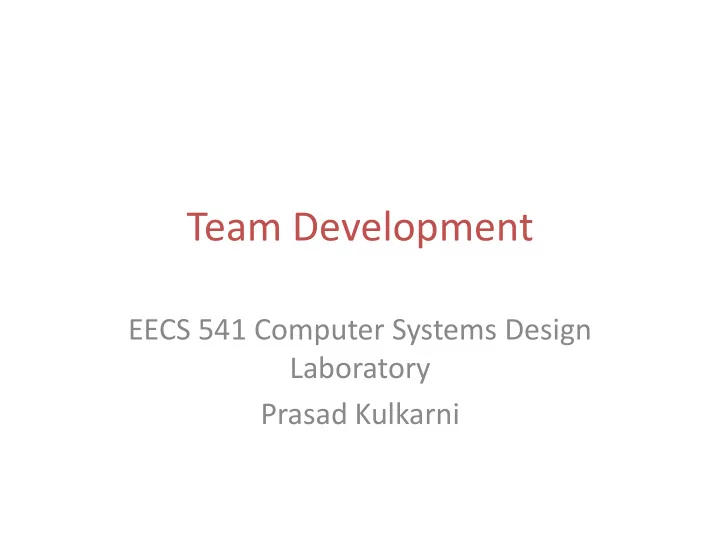

Team Development EECS 541 Computer Systems Design Laboratory Prasad Kulkarni
Team Size and Composition • Small: 3 — 5, Large: >8 or so – small teams can work faster, be more productive – large teams should have an expert facilitator, create sub-teams, can produce more ideas • Teams should include people with different skills – technical experts, administrative skills, interpersonal and communication skills • Teams should include people with different and diverse personality traits – Myers-Briggs Type Indicator (MBTI) – Five Factor Model (FFM) – Belbin’s nine roles required for successful teams – identify traits in people and assign them to teams EECS 541 Computer Systems Design Lab 2
Myers-Briggs Type Indicator • Wikipedia – an introspective self-report questionnaire designed to indicate psychological preferences in how people perceive the world and make decisions • Four preferences – myersbriggs.org • Favorite world – do you prefer to focus on the outer world (Extraversion - E) or on your own inner world (Introversion - I)? • Information – do you prefer to focus on the basic information you take in (Sensing – S) or do you prefer to interpret and add meaning (Intuition – N)? EECS 541 Computer Systems Design Lab 3
Myers-Briggs Type Indicator – 2 • Decisions – when making decisions, do you prefer to first look at logic and consistency (Thinking – T) or first look at the people and special circumstances (Feeling – F)? • Structure – in dealing with the outside world, do you prefer to get things decided (Judging – J) or do you prefer to stay open to new information and options (Perceiving – P)? • Decision on each category gives your personality score as a four letter code. EECS 541 Computer Systems Design Lab 4
Myers-Briggs Type Indicator – 3 • References – https://en.wikipedia.org/wiki/Myers%E2%80%93Brigg s_Type_Indicator – http://www.myersbriggs.org/my-mbti-personality- type/mbti-basics/ – http://www.humanmetrics.com/cgi-win/jtypes2.asp – https://www.quora.com/What-is-the-most-accurate- free-online-Myers-Briggs-test – http://www.16personalities.com/free-personality-test EECS 541 Computer Systems Design Lab 5
Five Factor Model • Covers different personality aspects of team members – Extraversion – defined by adjectives; active, assertive, energetic, enthusiastic, outgoing, talkative – Agreeableness – defined by adjectives; appreciative, forgiving, generous, kind, sympathetic, trusting – Conscientiousness – defined by adjectives; efficient, organized, planful, reliable, responsible, through – Neuroticism – defined by adjectives; anxious, self- pitying, tense, touchy, unstable, worrying – Openness – defined by adjectives; artistic, curious, imaginative, insightful, original, wide-interests 1. McCrae, Robert R., & John, Oliver P. (1992, June), An Introduction to the Five-Factor Model and Its Applications , published in the Journal of Personality, vol. 60:2, Blackwell Publishing Ltd. EECS 541 Computer Systems Design Lab 6
Five-Factor Model – 2 • Extraversion – may increase team viability and communication • Agreeableness – may increase team cohesion, communication and productivity • Conscientiousness – may increase overall team performance • Neuroticism – (or emotional stability) may increase cohesion and overall performance • Openness – may lead to increase in communication EECS 541 Computer Systems Design Lab 7
Belbin’s Nine Roles for Successful Teams • Leader and organizer (usually one) • Hands-on worker (more than one may be needed) • Realist or “naysayer” • Conformist or utility worker • Artist or designer • Social worker who helps to ease team relationships • Specialist • Resource investigator • Motivator 1. Belbin, R.M. (1981). Management Teams: Why They Succeed or Fail. Oxford: Heineman Professional Publishing. 2. DeAgostino, T. H., & Jovanovic, V. M., & Thomas, M. B. (2014, June), Simulating Real-World Work Experience in Engineering Capstone Courses Paper presented at 2014 ASEE Annual Conference, Indianapolis, Indiana. https://peer.asee.org/23016 EECS 541 Computer Systems Design Lab 8
Team Roles – Other Literature • Leader – prepare/lead meeting, direct team activities towards goals, ensure productivity • Facilitator – ensure equal participation, mediate/resolve conflicts, support leader • Member – includes all, offer ideas and perspectives, actively participate, complete assignments on time • Recorder – take meeting minutes, distribute meetings to team members • Timekeeper – ensure team stays on time budget EECS 541 Computer Systems Design Lab 9
Bruce Tuckman’s Stages of Team Development • Forming – anxious, polite interactions, role unclear, excitement about task ahead • Storming – conflict due to different working styles, criticism of ideas and team goals, polarization, coalition forming • Norming – reduction in role ambiguity, work together, respect roles in team, team feeling • Performing – all cooperating, working hard to achieve team goals, some leaving or joining the team does not affect productivity EECS 541 Computer Systems Design Lab 10
Recommendations for this Class • Team sizes should be between 3-5 • Rotate team roles • Document minutes of team meetings • Be active listener, supportive, cooperative, participate in all team meetings, show respect for others’ contributions, share responsibility and success/failure of team EECS 541 Computer Systems Design Lab 11
Assignments and Deadlines • Complete MBTI/personality assessment test – will be sent via email – verify that team is diverse and adapt – Deadline – Oct. 24 th • Assign and rotate team roles • Document all team meetings • For each project submission, each team member will score every other team member – will be used to assign differential score to members on the same team • October 24 th is deadline for initial proposal submission – initiate discussions with me and the GTA EECS 541 Computer Systems Design Lab 12
Recommend
More recommend